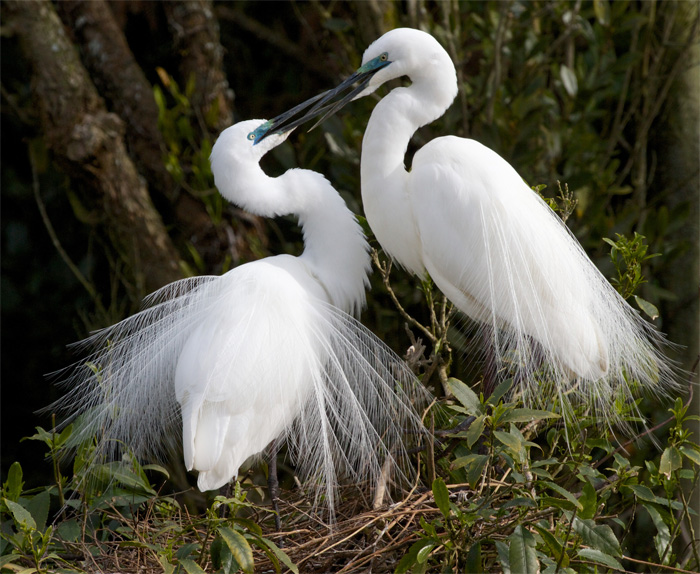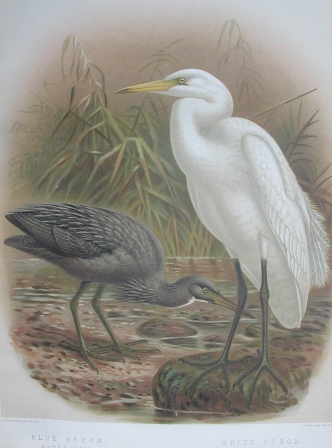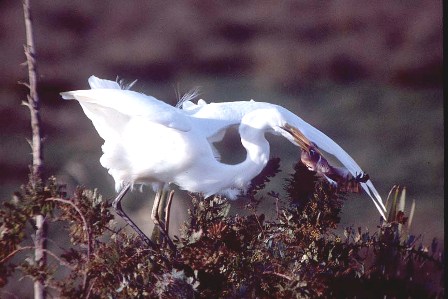


Photograph by: White Heron Sanctuary Tours
We do see Kōtuku, the white heron around here in the eastern Bay of Plenty on occasions, at Matata usually, a rare solitary bird towering above the more pedestrian white faced herons and ducks. Such beautiful birds as they lift themselves off into flight, the wings flapping slowly and purposefully.
Kōtuku, white heron or great egret is a cosmopolitan bird and is found worldwide in tropical and temperate regions. Of the four or more subspecies, the range of the largest, Egretta alba modesta, is India, China, Japan, Australia and New Zealand. The birds are venerated in most parts of their Asiatic range, the fragile white plumes which they assume and shed each breeding season have been universally prized for ornament.
Geographically and climatically New Zealand is near the extreme limits of its range. In New Zealand it is a rare bird, and probably always has been. However the species was almost exterminated to satisfy the demand for feathers for women’s hats after its only breeding site on the banks of the Waitangiroto River near Whataroa in South Westland was discovered in 1865. By 1941 there were only four nests when it was declared a reserve and patrolled at breeding time. The numbers have now stabilised with a permanent population of around 200 – 250.
The shallow waters along the margins of rivers, inland lakes, swamps and coastal estuaries, including sometimes the beach are the stations frequented by Kōtuku. Its long legs, bare of feathers well above the ankle joint, and long spreading toes fit it especially for wading on a muddy bottom. They are solitary feeders. At night when not feeding they roost in trees. Their voice is the typical heron croak in flight or when disturbed.
Kōtuku’s food consists of mainly small fishes, including eels. Standing in water as deep as its long legs will allow without wetting its feathers, it remains perfectly still until a fish comes within reach, then with lightning like rapidity it strikes and at once swallows its prey. According to Oliver, the ornithologist, in addition to fish, its food includes, frogs, tadpoles, insects and even birds.
The nesting site on the banks of the Waitangiroto River within the Waitangiroto Nature Reserve is not far from the Okarito Lagoon which is just a few miles from the sea. It is a kahikatea swamp through which the sluggish river moves down to the sea.
Adult birds start arriving from all over the country around mid-September and take part in elaborate courtship displays. Males build small platforms from which they advertise themselves to females. Displays of the male include a spectacular raising of the nuptial plumes, with the neck erect, the bill snapping and the wing feathers flicking. Once a female is attracted, the pair preen each other and intertwine their long necks, wings and bill. The female builds the real nest platform. According to Oliver, the nests are placed in trees or in the crowns of tree ferns near to or overhanging water and at various heights from eight to forty feet,(three to thirteen metres). The nests are well built of sticks and fern fronds. Three to five eggs are laid in October and November and the young are ready to fly in January and February. After breeding the birds disperse widely throughout the country.
Closely associated with the colony are nests of white–throated and little pied shags which are much more numerous. Since 1949, Royal spoonbills have come to breed among them, preferring to nest in the taller kahikatea.
The feathers of Kōtuku, like the Huia, were highly prized by Māori and were used to adorn the heads of chiefs both in life and after death. Kōtuku was kept alive by Māori in cages of basketwork and at intervals the wing quills were plucked from the unhappy birds. They did not live long. The feathers were kept, as were Huia feathers, in elaborately carved boxes.
In Māori oratory, the most telling compliment is to liken someone to Kōtuku. It symbolizes everything rare and beautiful. It was said that Kōtuku is an inhabitant of the nether world, the spirit land of Reinga, and that an old funeral chant ends with these words to the departed: “Ko to kōtuku to tapui, e Tama e – Kōtuku is now thy sole companion, O my son!”. So seldom does Kōtuku appear in any locality that “rare as the Kōtuku” has passed into a proverb among Maori.


Kōtuku and reef heron from Walter Lawry Buller's, Birds of New Zealand, 1888.
| Taxonomy | |
|---|---|
| Kingdom: | Animalia |
| Phylum: | Chordata |
| Class: | Aves |
| Order: | Ciconiiformes. |
| Family: | Ardeidae. |
| Genera: | Egretta. |
| Species: | alba. |
| Sub Species: | modesta. |
Great egret, great white heron.
Native bird
92 cm., 900 g., entirely white in non-breeding plumage, iris and bill yellow, legs and feet black.
In September the adult birds undergo a change, commencing with the sporting of long white feathers of loose texture which lie over the back, wings, and tail like a bridal train. These are the nuptial or breeding plumes. The bill becomes black and the facial skin green. Before the change is complete, however, the adults depart their winter haunts and head for their Waitangiroto Nature Reserve breeding ground.
South Westland in the breeding season and during the winter scattered around New Zealand, North and South Islands and Stewart Island.
As territorial feeders they spread out and feed at lots of different locations in this area. They can be spotted in lakes and farm ponds up and down the South Westland area during the breeding season (eg Lake Mapourika, Lake Ianthe and Lake Mahinapua, Lake Paringa).
He Kōtuku rerenga tahi.
A Kōtuku’s flight is seen but once.
Nga kōtuku awe-nui o te uru
Ka moe whakaaio ki te mate.
The long-plumed white herons of the west sleep peacefully in death.

Photograph by: David Alexander
Buller, Walter Lawry, Birds of New Zealand, 1888.
Heather, B., & Robertson, H., Field Guide to the Birds of New Zealand, 2000.
Oliver, W.R.B. New Zealand Birds, 1955.
link to:
White Heron Sanctuary Tours
Sunday, 1 October, 2023; ver2023v1